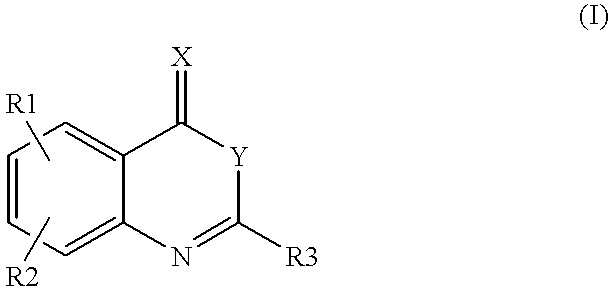Heterocyclic compounds regulating clotting
a technology of heterocyclic compounds and clotting, which is applied in the field of heterocyclic compounds regulating clotting, can solve the problems of severe bleeding, difficult to maintain the proper dosage of heparin, and undesirable side effects of treatment with heparin and other anticoagulants, so as to avoid the formation of undesired thrombosis and prevent the initiation of blood coagulation by fviia-tf
- Summary
- Abstract
- Description
- Claims
- Application Information
AI Technical Summary
Benefits of technology
Problems solved by technology
Method used
Image
Examples
example 1
5,8-Dichloro-2-(2-fluoro-phenyl)-4H-3,1-benzoxazin-4-one (1).
2-Amino-3,6-dichlorobenzoic acid (0.5 g) and triethyl amine (20 ml) were mixed. 2-Fluorobenzoyl chloride (0.77 g) was added dropwise under cooling and stirring. The mixture was subsequently heated to RT and stirred until disappearance of starting material was seen on TLC (silicagel) using heptane / ethyl acetate (4 / 1) as eluent. After cooling on ice the precipitate was filtered off and the filtrate evaporated to dryness. The residue was partitioned between methylene chloride and potassium carbonate (2N), the organic layers separated, dried over magnesium sulfate and evaporated to dryness. The raw product was purified by column chromatography on silicagel using heptane / ethyl acetate as eluent. Yield 0.31 g. m.p. 140.degree. C.
example 2
6-Methyl-2-thiophen-2-yl-4H-3,1-benzoxazin-4-one (2).
2-Amino-5-methylbenzoic acid (0.5 g) and triethyl amine (10 ml) were mixed in dry toluene (20 ml). 2-Thienylcarbonyl chloride (1.07 g) was added dropwise under cooling and stirring. The mixture was subsequently heated to RT for 24 h, then heated to 80.degree. C. for 1 h. After cooling on ice the precipitate was filtered off and the filtrate evaporated to dryness. The residue was partitioned between methylene chloride and potassium carbonate (2N), the organic layers separated, dried over magnesium sulfate and evaporated to dryness. The raw product was purified by column chromatography on silicagel using heptane / ethyl acetate as eluent.
Yield 0.77 g. m.p. 180.degree. C.,
example 3
2-(2,6-Dichloro-phenyl)-6-methyl-4H-3,1-benzoxazin-4-one (3).
2-Amino-5-methylbenzoic acid (0.5 g) and triethyl amine (10 ml) were mixed in dry toluene (20 ml). 2,6-Dichlorobenzoyl chloride (1.52 g) was added dropwise under cooling and stirring. The mixture was subsequently heated to RT for 24 h, then heated to 80.degree. C. for 1 h. After cooling on ice the precipitate was filtered off and the filtrate evaporated to dryness. The residue was partitioned between methylene chloride and potassium carbonate (2N), the organic layers separated, dried over magnesium sulfate and evaporated to dryness. The raw product was purified by column chromatography on silicagel using heptane / ethyl acetate as eluent.
Yield 0.12g, m.p. 153.degree. C.
PUM
| Property | Measurement | Unit |
|---|---|---|
| flow rate | aaaaa | aaaaa |
| pharmaceutical composition | aaaaa | aaaaa |
| molecular weight | aaaaa | aaaaa |
Abstract
Description
Claims
Application Information
 Login to View More
Login to View More - R&D
- Intellectual Property
- Life Sciences
- Materials
- Tech Scout
- Unparalleled Data Quality
- Higher Quality Content
- 60% Fewer Hallucinations
Browse by: Latest US Patents, China's latest patents, Technical Efficacy Thesaurus, Application Domain, Technology Topic, Popular Technical Reports.
© 2025 PatSnap. All rights reserved.Legal|Privacy policy|Modern Slavery Act Transparency Statement|Sitemap|About US| Contact US: help@patsnap.com



